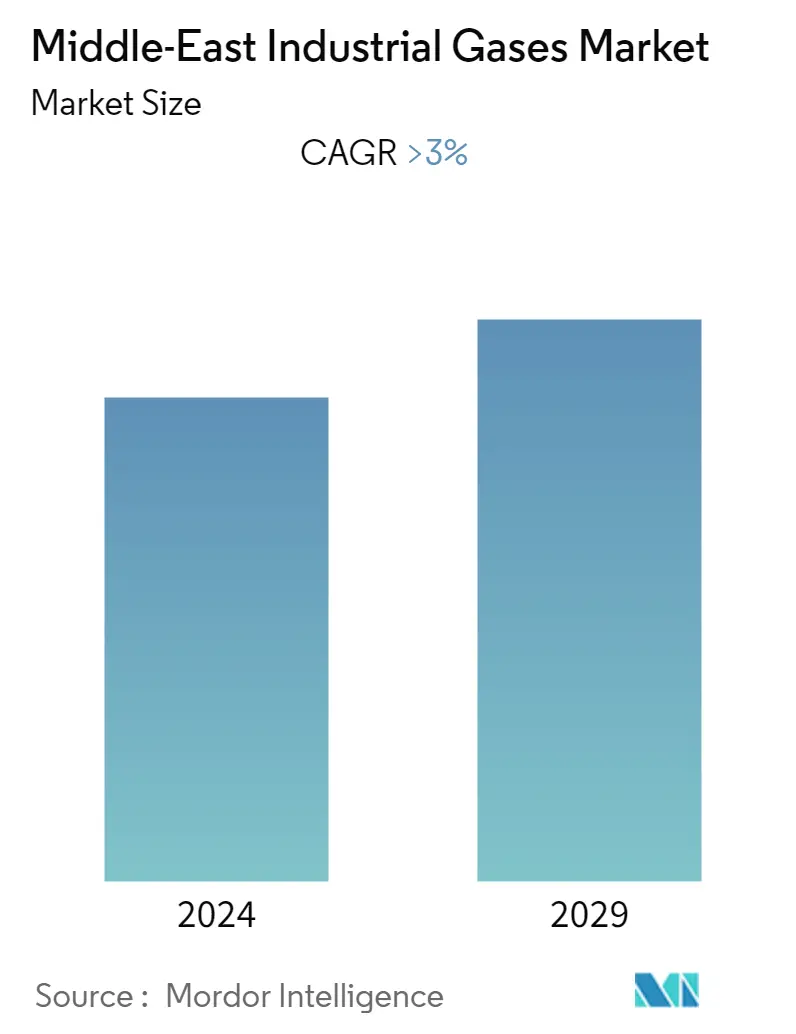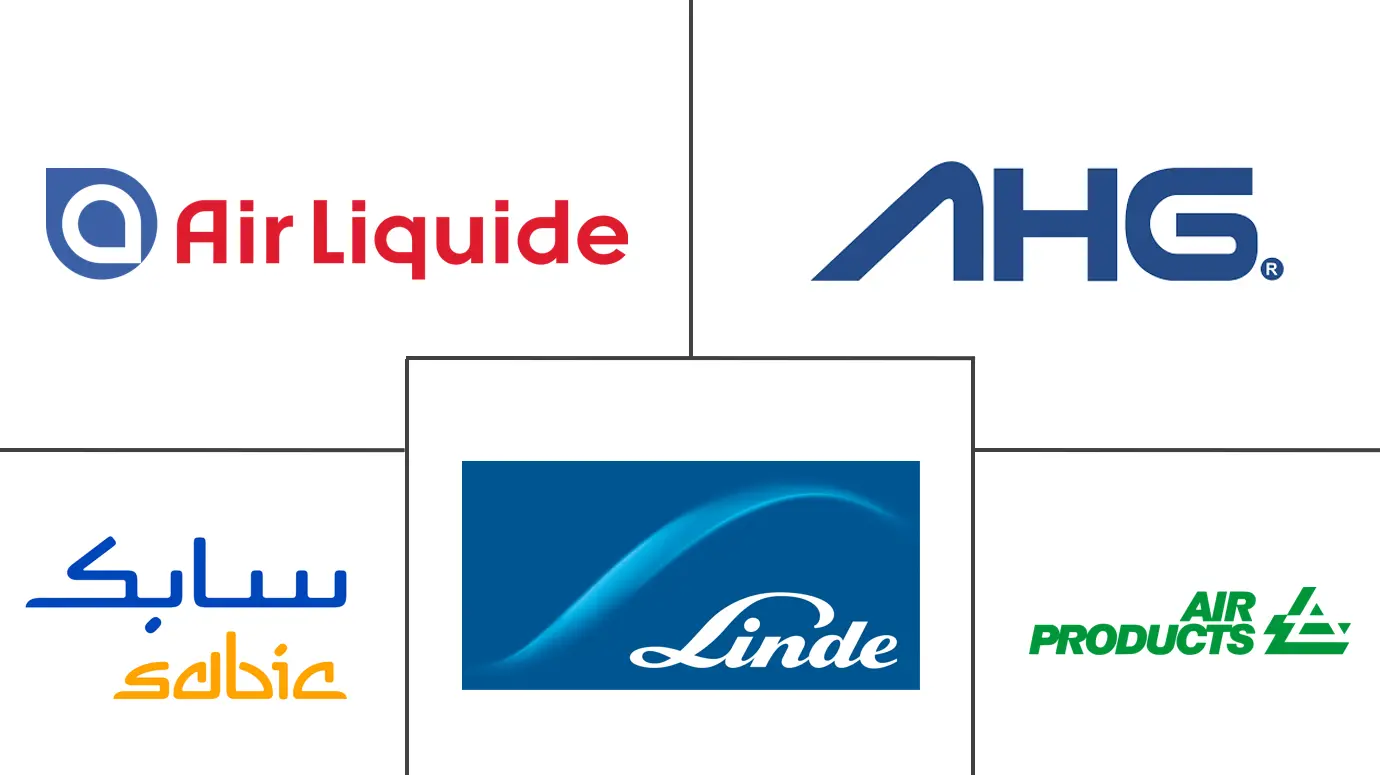Market Size of Middle-East Industrial Gases Industry

| Study Period | 2019 - 2029 |
| Base Year For Estimation | 2023 |
| Forecast Data Period | 2024 - 2029 |
| Historical Data Period | 2019 - 2022 |
| CAGR | > 3.00 % |
| Market Concentration | High |
Major Players
*Disclaimer: Major Players sorted in no particular order |
Middle-East Industrial Gases Market Analysis
The Middle Eastern industrial gases market is estimated to reach 50.35 million tons by the end of this year. It is projected to reach 60.58 million tons in the next five years, registering a CAGR of 3.77% during the forecast period.
The COVID-19 pandemic affected several industries negatively. The lockdown in most countries in the region caused disruptions in industrial activities and freight transportation that disturbed the supply chain in nearly every end-user industry. However, the conditions started recovering in 2021, restoring the market's growth trajectory.
- Over the short term, growing demand from the oil and gas industry and the growing need for alternate energy sources are major factors driving the market's growth.
- However, the environmental regulations and safety issues concerning industrial gases are likely to restrain the market's growth.
- Nevertheless, the growing demand for low-carbon gases in the coming years will likely create lucrative growth opportunities for the market in the coming years.
- Saudi Arabia represents the region's largest industrial gas market and is likely to witness strong growth in demand on the back of increasing oil and gas production and refining and chemical production capacities.
Middle-East Industrial Gases Industry Segmentation
Industrial gases are produced in relatively large quantities by gas manufacturing companies for use in various industrial manufacturing processes. These gases are sold to other enterprises and industries, including oil and gas, petrochemicals, chemicals, power, mining, steelmaking, metals, environmental protection, medicine, pharmaceuticals, biotechnology, food, water, fertilizers, nuclear power, and electronics.
The Middle Eastern industrial gases market is segmented by product type, end-user industry, and geography. By product type, the market is segmented into nitrogen, oxygen, carbon dioxide, hydrogen, helium, argon, ammonia, methane, propane, butane, and other types (fluorine and nitrous oxide). By end-user industry, the market is segmented into chemical processing and refining, electronics, food and beverage, oil and gas, metal manufacturing and fabrication, medical and pharmaceutical, automotive and transportation, energy and power, and other end-user industries (water treatment and environmental protection). The report also covers the market size and forecasts for the Middle Eastern industrial gases market in three countries across the Middle Eastern region.
For each segment, the market sizing and forecasts are provided on the basis of volume (tons).
| By Product Type | |
| Nitrogen | |
| Oxygen | |
| Carbon dioxide | |
| Hydrogen | |
| Helium | |
| Argon | |
| Ammonia | |
| Methane | |
| Propane | |
| Butane | |
| Other Product Types (Fluorine and Nitrous oxide) |
| By End-user Industry | |
| Chemical Processing and Refining | |
| Electronics | |
| Food and Beverage | |
| Oil and Gas | |
| Metal Manufacturing and Fabrication | |
| Medical and Pharmaceutical | |
| Automotive and Transportation | |
| Energy and Power | |
| Other End-user Industries (Water Treatment and Environmental Protection) |
| By Geography | |
| Saudi Arabia | |
| United Arab Emirates | |
| Qatar | |
| Rest of Middle East |
Middle-East Industrial Gases Market Size Summary
The Middle Eastern industrial gases market is experiencing a steady growth trajectory, driven primarily by the robust demand from the oil and gas sector. The region's strategic position as a hub for oil production, with countries like Saudi Arabia, the United Arab Emirates, and Iraq leading the charge, underscores the significance of industrial gases in enhancing extraction and refining processes. The market's expansion is further supported by initiatives such as Saudi Arabia's Vision 2030, which aims to diversify the economy and increase local content through industrial development. Despite challenges posed by environmental regulations and safety concerns, the market is poised for growth, particularly with the increasing interest in low-carbon gases and hydrogen projects, such as the NEOM Green Hydrogen project in Saudi Arabia.
The market landscape is characterized by a partially consolidated structure, with key players like Linde PLC, Air Liquide, Air Products and Chemicals Inc., SABIC, and Abdullah Hashim Industrial Gases & Equipment (AHG) playing pivotal roles. These companies are actively involved in strategic expansions and collaborations to strengthen their market positions. For instance, Air Products' agreement with Saudi Ground Services to demonstrate hydrogen mobility solutions highlights the growing focus on sustainable energy alternatives. Additionally, the acquisition of Air Liquide's industrial merchant gases business in the UAE by Air Products signifies ongoing consolidation efforts within the industry. As the demand for industrial gases continues to rise, driven by both traditional and emerging energy sectors, the Middle Eastern market is expected to maintain its upward momentum over the forecast period.
Middle-East Industrial Gases Market Size - Table of Contents
-
1. MARKET DYNAMICS
-
1.1 Drivers
-
1.1.1 Increasing Demand from the Oil and Gas Industry
-
1.1.2 Growing Need for Alternate Energy Sources
-
1.1.3 Other Drivers
-
-
1.2 Restraints
-
1.2.1 Environmental Regulations and Safety Issues
-
1.2.2 Other Restraints
-
-
1.3 Industry Value Chain Analysis
-
1.4 Industry Attractiveness - Porter's Five Forces Analysis
-
1.4.1 Bargaining Power of Suppliers
-
1.4.2 Bargaining Power of Buyers
-
1.4.3 Threat of New Entrants
-
1.4.4 Threat of Substitute Products and Services
-
1.4.5 Degree of Competition
-
-
-
2. MARKET SEGMENTATION (Market Size in Volume)
-
2.1 By Product Type
-
2.1.1 Nitrogen
-
2.1.2 Oxygen
-
2.1.3 Carbon dioxide
-
2.1.4 Hydrogen
-
2.1.5 Helium
-
2.1.6 Argon
-
2.1.7 Ammonia
-
2.1.8 Methane
-
2.1.9 Propane
-
2.1.10 Butane
-
2.1.11 Other Product Types (Fluorine and Nitrous oxide)
-
-
2.2 By End-user Industry
-
2.2.1 Chemical Processing and Refining
-
2.2.2 Electronics
-
2.2.3 Food and Beverage
-
2.2.4 Oil and Gas
-
2.2.5 Metal Manufacturing and Fabrication
-
2.2.6 Medical and Pharmaceutical
-
2.2.7 Automotive and Transportation
-
2.2.8 Energy and Power
-
2.2.9 Other End-user Industries (Water Treatment and Environmental Protection)
-
-
2.3 By Geography
-
2.3.1 Saudi Arabia
-
2.3.2 United Arab Emirates
-
2.3.3 Qatar
-
2.3.4 Rest of Middle East
-
-
Middle-East Industrial Gases Market Size FAQs
What is the current Middle-East Industrial Gases Market size?
The Middle-East Industrial Gases Market is projected to register a CAGR of greater than 3% during the forecast period (2024-2029)
Who are the key players in Middle-East Industrial Gases Market?
Linde PLC, Air Liquide, SABIC, Abdullah Hashim Industrial Gases & Equipment (AHG) and Air Products and Chemicals Inc. are the major companies operating in the Middle-East Industrial Gases Market.

